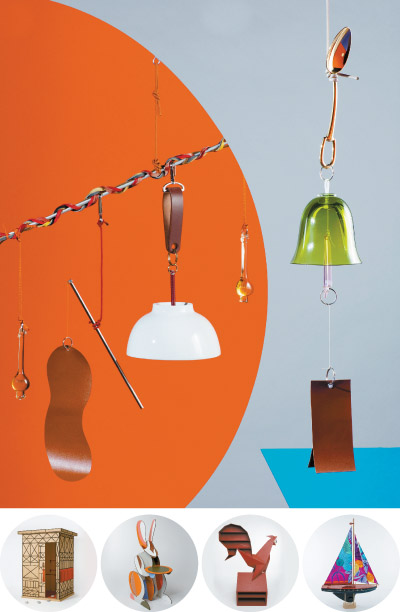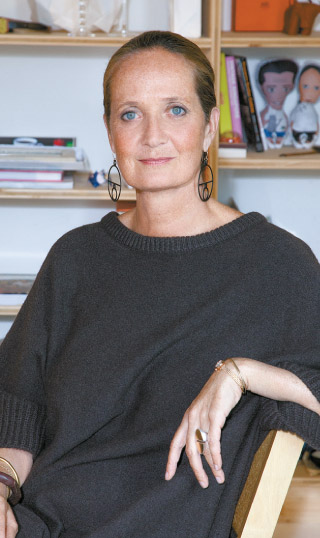One man’s trash is another’s luxurious creation : Hermes upcycling brand Petit h comes to Seoul for inspiration

Pictured above are the artworks within the Petit h collection, which are upcycled from materials that have been left over from making Hermes products. An exhibition of the collection will run through Dec. 17 at the Maison Hermes Dosan Park in Apgujeong, southern Seoul. [HERMES KOREA]
The brand started a collection named Petit h in 2010, which uses excess materials that remain after making their products. Using bits and pieces of leather, silk, crystal and porcelain, the artists and craftsmen at the French house create new works of art every year. This autumn, the works have flown to Seoul to be on display at the Maison Hermes Dosan Park in Apgujeong, southern Seoul, until Dec. 17.
The upcycled works are made exclusively in a workshop in Pantin, France, led by a sixth-generation member of the Hermes family, Pascale Mussard, who is also the maternal cousin to Axel Dumas and Pierre-Alexis Dumas, the chief executive officer of Hermes and artistic director of Hermes.
Before entering the fashion industry through her styling agency “Nicole De Vesian,” Mussard had actually graduated from a business school in Europe with a law degree. Her path led her to the Hermes house in 1978, where she ended up opening the Petit h workshop in 2010, and now works as the artistic director for the collection. The JoongAng Sunday, an affiliate of the Korea JoongAng Daily, had the chance to get in touch with Mussard before the exhibition began on Nov. 22. The following are edited excerpts of the interview.

A sixth-generation member of the Hermes family, Pascale Mussard has led the Petit h collection team since 2010. [HERMES KOREA]
A. I attribute the concept of Petit h to my education. I’ve always had people around me who were very creative, providing [inspiration through] their way of life. My father was an architect. My mother was an extremely creative woman, an extraordinary traveler, an outstanding storyteller, always ready to go around the world with a backpack, discovering materials at a time when few traveled. My grandparents also influenced me.
What influenced you to make the Petit h series?
I think it happened because of two factors. The first was that I was born shortly after World War II, at an extraordinarily happy time, after a long period of hardships, when it was not possible to find products or materials on the market, and everything that was available was of enormous importance. I was born at a time when the overwhelming feeling was that everything should be saved and reused because of their shortage. The second was my rather strict Protestant education, in which nothing was thrown away, beauty was found in everything and everything was kept. I developed this naturally, since it was so at home.
Were there past experiences that helped you give birth to Petit h?
During my life and then career at Hermes I have also learnt from my parents, grandparents, from my family that you have to keep human values at the heart of the maison. As a fabric buyer in the women’s ready-to-wear department, I have learned about textiles and the key point: a good quality material, fabric or leather, makes a good product, as in a kitchen or in a garden. During my experience as press attachee, I had the chance to deeply enter in to every [position] of our house and to work closely with Jean Louis Dumas to understand the philosophy of Hermes. As a visual merchandiser, I was able to discover the world of imagination of every artist. As co-artistic director, I have been very close to all the craftsmen.
It has been a wonderful experience that led me to what I am doing today. Through all these experiences, I have learnt to understand the designers, to respect the craftsman, to love, to admire creation and innovation. And then I had the dream of gathering all the know-how that we have at Hermes in one place: a creative laboratory nurturing the invention and creation of all form of objects.
How does the creative process begin for Petit h?
At Petit h the idea of a new object starts with a material, it could be an unused piece of silk, of leather or crystal, or a former [piece of] hardware from a leather bag. I invite designers and artists to what I call “Alibaba’s cavern,” at the workshops of Petit h, a place where all the different “sleeping” materials not any more in use by Hermes are gathered like acorns. They have free rein to explore and create. Like all Hermes objects, their objects will be the result of a journey with its own story.
Before starting Petit h and since childhood, I used to collect everything that wasn’t used. Then, working with the “metier” teams, I kept them preciously. Since 2009, I have been in direct contact with all the [material] from Hermes and from the Group. They are the ones who provide me. It is our incredible Alibaba’s cave and the starting point of all the creations for Petit h for our designers.
How many artists are there in the workshop, and how many pieces of work have you made so far?
[There are] 68 artists [who] collaborate for Petit h and 19 are in process of creation. We developed 160 new projects in 2016.
What are some key elements of the works within the Petit h collection?
The objects need to be functional and have a certain understated style (shape proportions) that is true to the house. The artists transform them using their eyes, their creativity and their hearts with the help of the expert hands of the house’s artisans. The idea is to create exceptional objects that are unique in their spirit of invention and in the quality of their execution. Rebirth and “upcycling” is the underlying approach. At Petit h, a laboratory of recreation, we test our limits in terms of shapes, material, colors and techniques. We recreate, resew, renovate, remake, reinvent.
Have you tried a new technique for this exhibition?
I have always had some great tenderness for repaired objects, the reinvented ones, the different techniques from a country to another: “piques” from Provence, patchworks from the United States, the Japanese Boro, the Kintsugi technique in Japan. There’s one technique in Korea, called nubi that I discovered thanks to Seulgi Lee’s reinterpretation for Hermes Maison. I discovered Hahoe masks and the Bogagi tradition thanks to a Korean student, Jiwon Choi. We have worked together on cashmere masks that we will present in Seoul.
Could you give details about some of the works?
Every project is chosen for its interest. There are some materials, the uses on which we [have been] working on since the beginning of Petit h. Those are experiences that make us grow. For instance, we imagined a tiger for Seoul. It was first imagined in printing leather but it wasn’t rewarding enough: the craftsman and the designer Marjolijn Mandersloot worked together on different perspectives. The result is innovating and assembles several techniques: a leather sculpture, leather goods and a superposition of leather stripes. [It took] 222 hours and 189 pieces of leather. Another example: the rooster-shape bookshelf made from the origami technique [95 sides], stitched, and polished on a metal structure [took] 225 hours of work.
The workshop gathers all the materials from the metiers allowing designers to invent and imagine the materials for the future: this is what I strongly encourage every day. For example, in [the exhibition in] Korea, you will see a crystal clock on a leather and wood miniature stool called “Pippa”; porcelain, perfume and leather will be used for Christmas tree baubles, and Terrazo will be used for pendants.
Was there an identity of Hermes that you wanted to infuse within the works of Petit h?
Petit h objects are Hermes objects. At Hermes the objects speak. They are nourished by the soul and the hand of the craftsman. They are designed, created, pampered, shaped, dreamed, ennobled, and sublimated. They are made with respect, love, fantasy and passion. At Petit h the materials come back to life to become unique objects, hybrid and poetic and useful. And this is because at Hermes beauty is inscribed in use, and use, in beauty. Nothing is superfluous. Honesty and perfection are at every step on the way; from design to production.
And, of course, as for all Hermes products, Petit h objects can be repaired. They are imagined to ennoble while aging, to be passed on.
Have you prepared something special for Korea?
I love surprise, so come and see our new “dreams.” Jean-Louis Dumas used to say that dreams are a first necessity. To me, sales must be surprises. The Korean culture has inspired us a lot. For example, the tiger, the rooster, nature.
The successful meetings with Jung Yeon-doo and the Hermes Korean team were also a great source of inspiration as they led us to an enchanted and magical garden.
Was there a reason you chose Jung Yeon-doo as your collaborative artist?
Every Petit h project in the world is an experience with the country that is welcoming us. In Germany, I worked with a painter; in the United States, with architects; in Japan, with the artistic director of Muji, the first time and the second time, with a graphic designer. In Korea, thanks to Julia Kim, I met with many designers, all of them were very interesting. I chose to work with Yeondoo because it was for us a new experience to be working with a photographer/filmmaker. I particularly liked his world, his fantasy, his colors and it was the beginning of a wonderful adventure. I was very interested in his vision and his propositions on Petit h Moreover, he had been noticed by Hermes [and participated in the Hermes Foundation Missulsang annual contemporary art exhibition.]
What expectations do you have for the exhibition in Korea?
I came to work at Dosan Park when Hermes opened a store there. It was my first trip to Korea. For 10 years, Hermes has been building a beautiful complicity with this country. I am happy to come back with a new project, meeting with our friends, clients and partners. It is a tribute to our craftsmen and designers. It is also a beautiful way for us to get to better know your traditions, the Hermes Korean team and to exchange with clients. I hope that Petit h will move the Dosan Park clients.
BY JUNG HYUNG-MO [yoon.soyeon@joongang.co.kr]
The exhibition runs through Dec. 17. Admission is free, from 11 a.m. to 8 p.m. from Monday through Saturday, and 12 p.m. to 8 p.m. on Sunday. Maison Hermes Dosan Park is a 10-minute walk from Apgujeongrodeo station, Bundang Line, exit 5. For more information, visit www.maisondosanpark.hermes.com










with the Korea JoongAng Daily
To write comments, please log in to one of the accounts.
Standards Board Policy (0/250자)